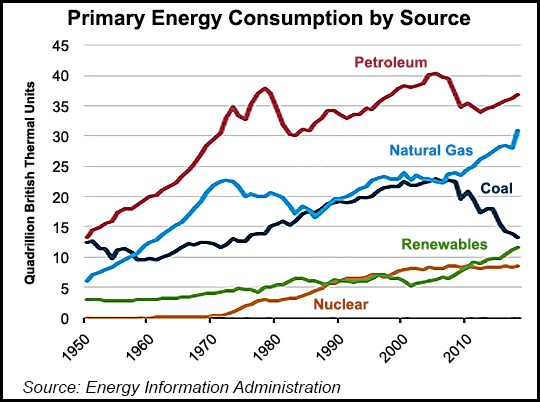Markets | NGI All News Access | NGI The Weekly Gas Market Report
U.S. Natural Gas Consumption Hit Record High in 2018, Says EIA
Total energy consumption in the United States was more than 101 quadrillion Btu (quads) last year, a record high, with the use of natural gas, the second largest source of energy in the country, also soaring to new heights, according to the Energy Information Administration (EIA).

Natural gas consumption in 2018 totaled 29.96 Tcf, up from 27.13 Tcf in 2017, according to EIA. The previous high was 27.44 Tcf in 2016. Through the first five months of the year 2019 is outpacing 2018 consumption, with 13.53 Tcf used so far, compared with 13.17 Tcf over the same time last year.
“Natural gas consumption has increased substantially since the mid-2000s, mostly as a result of increases in natural gas-fired electricity generation,” EIA said in its latest Monthly Energy Review. “In 1950, the industrial sector consumed the most natural gas (59%) in the United States, and the electric power sector consumed only 11%. In 2018, the U.S. electric power sector consumed more natural gas (35%) than the industrial sector (34%).”
Petroleum products, including gasoline, distillate fuel oil, and hydrocarbon gas liquids remain the largest sources of primary energy consumed in the United States with 70% of petroleum consumed for transportation in 2018. Petroleum shares to all other sectors have decreased since 1950, however, EIA said.
Coal consumption decreased in the United States in 2018 for the fifth consecutive year, reaching 13.2 quads, the lowest level since 1975 and about half of its peak in 2005. Meanwhile, renewable energy consumption reached a record 11.5 quads and nuclear energy consumption hit a record 8.4 quads.
Despite record domestic consumption, the United States is on track to become a net energy exporter next year. Continued growth in natural gas and petroleum exports, fueled by growing production from unconventional plays will spur exports, according to long-term projections released by the EIA earlier this year.
Large increases in natural gas, natural gas plant liquids and crude oil production, coupled with slow growth in domestic energy consumption, will tip the scales to net exports for the first time since 1953 beginning in 2020, according to EIA. The United States became a net exporter of natural gas in 2017 for the first time since 1958, as increasing shipments of liquefied natural gas to world markets and pipeline deliveries to Mexico exceeded imports, and continued to export more gas than it imported last year.
Natural gas demand emerged as the global fuel of choice last year, particularly in the United States and China. Energy consumption worldwide increased by 2.3%, the fastest pace this decade, according to the International Energy Agency. Energy demand overall was driven by a robust global economy and stronger heating and cooling needs in some regions. Gas posted the strongest gains, accounting for 45% of the rise in consumption.
© 2024 Natural Gas Intelligence. All rights reserved.
ISSN © 1532-1231 | ISSN © 2577-9877 | ISSN © 1532-1266 |
